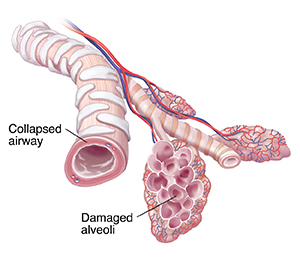Understanding Bullectomy
A bullectomy is a type of surgery on the lungs. It's done for a health problem called bullous emphysema. Bullous emphysema is a type of chronic pulmonary obstructive disease (COPD).
The lungs contain hundreds of tiny air sacs called alveoli. Emphysema is when there is damage to these air sacs over time. It's most often caused by cigarette smoking. With bullous emphysema, the normal small air sacs break down and form large air sacs called bullae. These large sacs don’t work normally. And they can grow big enough to crowd out normal air sacs. This makes it harder to breathe. You may have a regular cough and phlegm. A bullectomy can be done to remove the bullae. This helps make breathing easier.
 |
| Airway with emphysema. |
When do you need a bullectomy?
Surgery may be done to remove the bullae if they cause the issues listed below:
-
Severe breathing problems
-
Pain in your lungs
-
Gas in the space around the lung (pleural cavity)
-
Lung infections that won’t go away or keep coming back
-
Coughing up blood-tinged spit
If you have bullae in your lungs, you shouldn't smoke. If you smoke, talk with your healthcare provider about help with quitting.
You and your healthcare provider will decide whether this surgery is right for you. Your provider will take the size of the bullae into consideration. After surgery, you should be able to breathe better, with fewer symptoms.
What happens during surgery
On the day of your surgery, you will go to the hospital. Before the surgery begins, you will be given general anesthesia. This will make you go into a deep sleep, so you will not feel any pain during the surgery.
During the surgery, the surgeon will open your chest. They will make a small cut (incision) near your armpit. Or the surgeon will make several small cuts in your chest. The surgeon will put a small tube and camera (thoracoscope) into your lung. The camera lets the surgeon see the inside of your lung. The surgeon will remove the extra air sacs. Then the surgeon will close the cuts with stitches (sutures).
What happens after surgery
You may wake up from surgery with a breathing tube. Once the breathing tube is removed, you may continue to need oxygen therapy. You will also have a tube in your chest to make sure that no air is leaking out of your lungs into your chest cavity. You’ll be given medicine to manage the pain.
You’ll likely stay in the hospital for a few days to a week. Full recovery will take a few weeks. Over that time, you’ll slowly go back to doing what you normally do, with a few limits. Your healthcare provider will explain what you can and can’t do after surgery.
As you recover in the hospital, your healthcare provider will likely have you get up and walk. Your provider will watch you for signs of complications. These are problems that can be caused by surgery. In the weeks after surgery, you will likely begin a rehabilitation (rehab) program. This will include exercises, information about your condition, and help with managing it.
Risks of this surgery
All surgery has risks. The risks of this surgery may include:
-
Air leaks from the lung into the body cavity
-
The lungs not getting enough oxygen into the blood (respiratory failure)
-
Lung infection (pneumonia)
-
Bleeding
-
Lung collapse
-
Blood clots (pulmonary embolism or deep vein thrombosis)
-
Irregular heartbeat (arrhythmia)